
decade3d – anatomy online/shutterstock.com
Chronic (CRS) and acute (ARS) rhinosinusitis affect many people: Nearly 29.4 million U.S. adults have been diagnosed with sinusitis, and 11.7 million visits to physician offices resulted in a primary diagnosis of CRS, according to the U.S. Centers for Disease Control.
Explore This Issue
May 2016The sheer amount of information available about ARS and CRS pathology and treatment is staggering, however, and the condition continues to be the subject of ever-widening research.
To help clinicians and researchers better find evidence-based information, the International Forum of Allergy & Rhinology recently published the “International Consensus Statement on Allergy and Rhinology: Rhinosinusitis (ICAR:RS).” The statement examines more than 140 topics relating to rhinosinusitis (RS), reviewing evidence-based studies and making recommendations based on that evidence (Int Forum Allergy Rhinol. 2016;6:S3-S21).
“By virtue of its timing and systematic approach, this manuscript has incorporated the most recent scientific studies and prior position papers, combining prior perspective with current literature,” said Abtin Tabaee, MD, associate professor of otolaryngology at Weill Cornell Medical College in New York City. “The authors have taken a comprehensive approach both in terms of the depth of the literature reviewed and the various diagnostic and treatment subtopics discussed, including the full spectrum of CRS diagnosis, medical therapy, surgical procedures, and postoperative care. By reviewing more of the relevant individual aspects of evaluation and treatment for CRS, the authors have expanded common critical aspects, such as antibiotics, to a more broad and encompassing conversation.”
Evidence-based pathology and guidelines are given for acute ARS, CRS both with and without nasal polyps (CRSwNP and CRSsNP), recurrent ARS (RARS), acute exacerbation of CRS (AECRS), and pediatric RS. The consensus statement also touches on medical and surgical management of ARS and CRS.
Richard R. Orlandi, MD, professor of otolaryngology–head and neck surgery at the University of Utah in Salt Lake City, was interested to find a lack of hard evidence on common clinical practices regarding RS. “There is a paucity of evidence, and what there is, is at a low quality level,” he said. “We have things we’re dogmatic about in practice but that we’ve found little to no evidence for in the clinical literature.”
Comprehensive Guidelines
New and compiled data available within the consensus statement include the following information:
Definitions and diagnostic criteria for the different forms of RS. Statement authors have compiled adult RS definitions based on how the disease manifests itself over time. (See “Definitions and Diagnostic Criteria,” p. 8) They also identify subacute RS as a diagnosis when the condition lasts more than four weeks but fewer than 12 weeks, while cautioning that its use should be limited until it’s better understood.